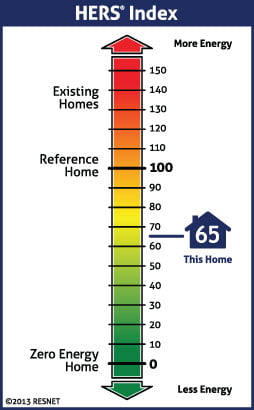Most builders and sales agents admit that in the home buying process, the decision is usually all “hers”! That’s also true in the valuation process of a new construction home that is touted as an energy efficient or green home: a key part of the process should be HERS – the Home Energy Rating System report.
An appraiser will have limited knowledge of the energy efficient features without the Home Energy Rating System report. Appraisers are not trained in building science and energy evaluations. They do not carry a blower door, duct blaster, or infrared camera in their bag of tools when inspecting a home. However, the appraiser can rely on an independent, third-party opinion of the home’s energy efficiency by understanding the home’s HERS rating.
The HERS Index was created in 2006 by the Residential Energy Services Network, known as RESNET, and has become the gold standard for rating the energy efficiency of a home. A HERS rating is based on a scale from 0 to 100+, where a lower number means the home will be more energy efficient. A HERS Index score of 100 represents a home built in compliance with 2006 energy efficiency standards, while a score of 0 represents a zero energy home – a home that produces about as much energy as it consumes on an annual basis.

The HERS index shows relative energy efficiency based on standard set of protocols.
HERS for Existing and Completed New Homes
Many multiple listings services (MLSs) now include a searchable field for a HERS rating. Real estate brokers should encourage sellers to perform a rating as they prepare their home for the market. But the local MLS is not the only place appraisers, agents, and buyers can find the energy rating. RESNET and the Appraisal Institute have launched an Appraiser Portal, a new online service that allows Appraisal Institute professionals focused on residential valuation to access important information about the energy efficiency of more than 2 million HERS-rated homes across the U.S. As buyers become more aware of how useful the HERS rating is to their buying decisions and monthly energy costs, sales data will quickly show why a property sold for more with a low HERS rating compared to a similar house with a higher HERS rating.
HERS for Construction Loans
In the case of new construction and when a mortgage is required, the appraisal is typically done from plans. Because a Confirmed Rating (included in the Appraiser Portal) is not possible until the house is built, the appraiser usually doesn’t see the HERS Rating, and therefore doesn’t consider energy efficiency as a feature to be analyzed. It is possible to rate the proposed or under construction house using a projected HERS rating. If builders would provide this to the appraiser at the time of appraisal, it would assist appraisers in more accurately valuing the home.
This will change as the secondary mortgage market guidelines continue to change with more emphasis on energy and green features. Fannie Mae, Freddie Mac, and FHA already require the appraiser to describe and analyze energy or green features. What better way to describe and analyze than to have a HERS Rating that takes the guessing out of the opinion!
This post originally appeared on Opinions of Value, the Appraisal Institute blog.
Sandra K. Adomatis, SRA, LEED Green Associate, is a nationally recognized expert on green and energy-efficient valuation. She has developed residential green appraisal courses and seminars for the Appraisal Institute and is the author of the AI-published book “Residential Green Valuation Tools.”
Ryan Meres, RESNET program director, has 10 years of experience in energy efficiency, energy policy and building energy codes and has published more than two dozen case studies, reports and resources on those topics. He is a LEED Accredited Professional, an ICC Certified Residential Energy Inspector/Plans Examiner and holds a bachelor’s degree in architecture from the Savannah College of Art and Design.


Sadie McKeown says:
I am a lender for multifamily properties in the northeast. my company, The Community Preservation Corporation underwrites energy performance into the financing of a property. However, we don’t have a lot of believers in our investor base or our appraisers. Is there a data base of HERS properties for multifamily buildings or is it just single family at this time? it would be very helpful and powerful to have this tool in the multifamily space.